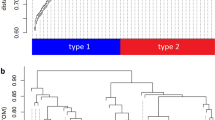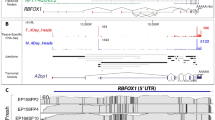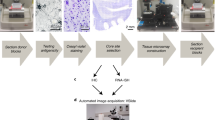Abstract
The diverse functions of the brain are mediated by neurons and glia whose phenotype is defined by a dynamically maintained set of gene transcripts, or 'transcriptome'. Large-scale analysis of gene expression in postmortem brain using microarray technology has the potential to elucidate molecular changes that occur in disease states. There are unique challenges associated with studies of postmortem brain, including limited sample sizes and variable clinical phenotypes that are typical of complex disorders. Nevertheless, recent microarray-based studies have implicated both individual dysregulated genes and abnormal patterns of gene expression in brain disorders.
This is a preview of subscription content, access via your institution
Access options
Subscribe to this journal
Receive 12 print issues and online access
$209.00 per year
only $17.42 per issue
Buy this article
- Purchase on Springer Link
- Instant access to full article PDF
Prices may be subject to local taxes which are calculated during checkout
Similar content being viewed by others
References
Schena, M., Shalon, D., Davis, R.W. & Brown, P.O. Quantitative monitoring of gene expression patterns with a complementary DNA microarray. Science 270, 467–470 (1995).
Lockhart, D.J. et al. Expression monitoring by hybridization to high-density oligonucleotide arrays. Nat. Biotechnol. 14, 1675–1680 (1996).
Cheung, V.G. et al. Making and reading microarrays. Nat. Genet. 21, 15–19 (1999).
Hoffman, E. et al. Guidelines: Expression profiling - best practices for data generation and interpretation in clinical trials. Nat. Rev. Genet. 5, 229–237 (2004).
Stuart, J.M., Segal, E., Koller, D. & Kim, S.K. A gene-coexpression network for global discovery of conserved genetic modules. Science 302, 249–255 (2003).
Blalock, E.M. et al. Incipient Alzheimer's disease: Microarray correlation analyses reveal major transcriptional and tumor suppressor responses. Proc. Natl. Acad. Sci. USA 101, 2173–2178 (2004).
Mirnics, K., Middleton, F.A., Lewis, D.A. & Levitt, P. Analysis of complex brain disorders with gene expression microarrays: schizophrenia as a disease of the synapse. Trends Neurosci. 24, 479–486 (2001).
Mirnics, K. Microarrays in brain research: the good, the bad and the ugly. Nat. Rev. Neurosci. 2, 444–447 (2001).
Colantuoni, C. et al. Gene expression profiling in postmortem Rett Syndrome brain: differential gene expression and patient classification. Neurobiol. Dis. 8, 847–865 (2001).
Pongrac, J., Middleton, F.A., Lewis, D.A., Levitt, P. & Mirnics, K. Gene expression profiling with DNA microarrays: advancing our understanding of psychiatric disorders. Neurochem. Res. 27, 1049–1063 (2002).
Greenbaum, D., Colangelo, C., Williams, K. & Gerstein, M. Comparing protein abundance and mRNA expression levels on a genomic scale. Genome Biol. 4, 117 (2003).
Pierri, J.N., Chaudry, A.S., Woo, T.U. & Lewis, D.A. Alterations in chandelier neuron axon terminals in the prefrontal cortex of schizophrenic subjects. Am. J. Psychiatry 156, 1709–1179 (1999).
Lewis, D.A. & Levitt, P. Schizophrenia as a disorder of neurodevelopment. Annu. Rev. Neurosci. 25, 409–432 (2002).
Lewis, D.A. The human brain revisited: opportunities and challenges in postmortem studies of psychiatric disorders. Neuropsychopharmacology 26, 143–154 (2002).
Harrison, P.J. et al. The relative importance of premortem acidosis and postmortem interval for human brain gene expression studies: selective mRNA vulnerability and comparison with their encoded proteins. Neurosci. Lett. 200, 151–154 (1995).
Quackenbush, J. Microarray data normalization and transformation. Nat. Genet. 32 (Suppl.), 496–501 (2002).
Smyth, G. & Speed, T. Normalization of cDNA microarray data. Methods 31, 265–273 (2003).
Tusher, V.G., Tibshirani, R. & Chu, G. Significance analysis of microarrays applied to the ionizing radiation response. Proc. Natl. Acad. Sci. USA 98, 5116–5121 (2001).
Li, C. & Hung Wong, W. Model-based analysis of oligonucleotide arrays: model validation, design issues and standard error application. Genome Biol. 2, 32.1–32.11 (2001).
Eisen, M.B., Spellman, P.T., Brown, P.O. & Botstein, D. Cluster analysis and display of genome-wide expression patterns. Proc. Natl. Acad. Sci. USA 95, 14863–14868 (1998).
Kerr, M.K. & Churchill, G.A. Bootstrapping cluster analysis: assessing the reliability of conclusions from microarray experiments. Proc. Natl. Acad. Sci. USA 98, 8961–8965 (2001).
Alizadeh, A.A. et al. Distinct types of diffuse large B-cell lymphoma identified by gene expression profiling. Nature 403, 503–511 (2000).
Evans, S.J. et al. DNA microarray analysis of functionally discrete human brain regions reveals divergent transcriptional profiles. Neurobiol. Dis. 14, 240–250 (2003).
Mukasa, A. et al. Distinction in gene expression profiles of oligodendrogliomas with and without allelic loss of 1p. Oncogene 21, 3961–3968 (2002).
Mirnics, K., Middleton, F.A., Marquez, A., Lewis, D.A. & Levitt, P. Molecular characterization of schizophrenia viewed by microarray analysis of gene expression in prefrontal cortex. Neuron 28, 53–67 (2000).
Hemby, S.E. et al. Gene expression profile for schizophrenia: discrete neuron transcription patterns in the entorhinal cortex. Arch. Gen. Psychiatry 59, 631–640 (2002).
Middleton, F.A., Mirnics, K., Pierri, J.N., Lewis, D.A. & Levitt, P. Gene expression profiling reveals alterations of specific metabolic pathways in schizophrenia. J. Neurosci. 22, 2718–2729 (2002).
Vawter, M.P. et al. Microarray analysis of gene expression in the prefrontal cortex in schizophrenia: a preliminary study. Schizophr. Res. 58, 11–20 (2002).
Tkachev, D. et al. Oligodendrocyte dysfunction in schizophrenia and bipolar disorder. Lancet 362, 798–805 (2003).
Mimmack, M.L. et al. Gene expression analysis in schizophrenia: reproducible up-regulation of several members of the apolipoprotein L family located in a high-susceptibility locus for schizophrenia on chromosome 22. Proc. Natl. Acad. Sci. USA 99, 4680–4685 (2002).
Hakak, Y. et al. Genome-wide expression analysis reveals dysregulation of myelination-related genes in chronic schizophrenia. Proc. Natl. Acad. Sci. USA 98, 4746–4751 (2001).
Mirnics, K., Middleton, F.A., Stanwood, G.D., Lewis, D.A. & Levitt, P. Disease-specific changes in regulator of G-protein signaling 4 (RGS4) expression in schizophrenia. Mol. Psychiatry 6, 293–301 (2001).
Chowdari, K.V. et al. Association and linkage analyses of RGS4 polymorphisms in schizophrenia. Hum. Mol. Genet. 11, 1373–1380 (2002).
Williams, N.M. et al. Support for RGS4 as a susceptibility gene for schizophrenia. Biol. Psychiatry 55, 192–195 (2004).
Morris, D.W. et al. Confirming RGS4 as a susceptibility gene for schizophrenia. Am. J. Med. Genet. 125, 50–53 (2004).
Lewohl, J.M. et al. Gene expression in human alcoholism: microarray analysis of frontal cortex. Alcohol Clin. Exp. Res. 24, 1873–1882 (2000).
Lewohl, J.M., Dodd, P.R., Mayfield, R.D. & Harris, R.A. Application of DNA microarrays to study human alcoholism. J. Biomed. Sci. 8, 28–36 (2001).
Albertson, D. et al. Gene expression profile of the nucleus accumbens of human cocaine abusers: evidence for dysregulation of myelin. J Neurochem. 88, 1211–1219 (2004).
Traynor, J., Agarwal, P., Lazzeroni, L. & Francke, U. Gene expression patterns vary in clonal cell cultures from Rett syndrome females with eight different MECP2 mutations. BMC Med. Genet. 3, 12 (2002).
Tudor, M., Akbarian, S., Chen, R.Z. & Jaenisch, R. Transcriptional profiling of a mouse model for Rett syndrome reveals subtle transcriptional changes in the brain. Proc. Natl. Acad. Sci. USA 99, 15536–15541 (2002).
Mycko, M.P., Papoian, R., Boschert, U., Raine, C.S. & Selmaj, K.W. cDNA microarray analysis in multiple sclerosis lesions: detection of genes associated with disease activity. Brain 126, 1048–1057 (2003).
Whitney, L.W. et al. Analysis of gene expression in mutiple sclerosis lesions using cDNA microarrays. Ann. Neurol. 46, 425–428 (1999).
Whitney, L.W., Ludwin, S.K., McFarland, H.F. & Biddison, W.E. Microarray analysis of gene expression in multiple sclerosis and EAE identifies 5-lipoxygenase as a component of inflammatory lesions. J. Neuroimmunol. 121, 40–48 (2001).
Lock, C. et al. Gene-microarray analysis of multiple sclerosis lesions yields new targets validated in autoimmune encephalomyelitis. Nat. Med. 8, 500–508 (2002).
Marcotte, E.R., Srivastava, L.K. & Quirion, R. cDNA microarray and proteomic approaches in the study of brain diseases: focus on schizophrenia and Alzheimer's disease. Pharmacol. Ther. 100, 63–74 (2003).
Colangelo, V. et al. Gene expression profiling of 12633 genes in Alzheimer hippocampal CA1: transcription and neurotrophic factor down-regulation and up-regulation of apoptotic and pro-inflammatory signaling. J. Neurosci. Res. 70, 462–473 (2002).
Loring, J.F., Wen, X., Lee, J.M., Seilhamer, J. & Somogyi, R. A gene expression profile of Alzheimer's disease. DNA Cell. Biol. 20, 683–695 (2001).
Mufson, E.J., Counts, S.E. & Ginsberg, S.D. Gene expression profiles of cholinergic nucleus basalis neurons in Alzheimer's disease. Neurochem. Res. 27, 1035–1048 (2002).
Ginsberg, S.D. et al. Predominance of neuronal mRNAs in individual Alzheimer's disease senile plaques. Ann. Neurol. 45, 174–181 (1999).
Ginsberg, S.D., Hemby, S.E., Lee, V.M., Eberwine, J.H. & Trojanowski, J.Q. Expression profile of transcripts in Alzheimer's disease tangle-bearing CA1 neurons. Ann. Neurol. 48, 77–87 (2000).
Yao, P.J. et al. Defects in expression of genes related to synaptic vesicle trafficking in frontal cortex of Alzheimer's disease. Neurobiol. Dis. 12, 97–109 (2003).
Pasinetti, G.M. Use of cDNA microarray in the search for molecular markers involved in the onset of Alzheimer's disease dementia. J. Neurosci. Res. 65, 471–476 (2001).
Mao, R., Zielke, C.L., Zielke, H.R. & Pevsner, J. Global up-regulation of chromosome 21 gene expression in the developing Down syndrome brain. Genomics 81, 457–467 (2003).
Pollack, J.R. et al. Genome-wide analysis of DNA copy-number changes using cDNA microarrays. Nat. Genet. 23, 41–46 (1999).
Hirose, Y. et al. Grade II astrocytomas are subgrouped by chromosome aberrations. Cancer Genet. Cytogenet. 142, 1–7 (2003).
Edgar, R., Domrachev, M. & Lash, A.E. Gene Expression Omnibus: NCBI gene expression and hybridization array data repository. Nucleic Acids Res. 30, 207–210 (2002).
Brooksbank, C. et al. The European Bioinformatics Institute's data resources. Nucleic Acids Res. 31, 43–50 (2003).
Brazma, A. et al. ArrayExpress—a public repository for microarray gene expression data at the EBI. Nucleic Acids Res. 31, 68–71 (2003).
Brazma, A. et al. Minimum information about a microarray experiment (MIAME)-toward standards for microarray data. Nat. Genet. 29, 365–371 (2001).
Causton, H.C. & Game, L. MGED comes of age. Genome Biol. 4, 351 (2003).
Mimmack, M.L. & Bahn, S. Quantitative RT-PCR in brain research. Biol. Psychiatry (in press).
Watase, K. & Zoghbi, H.Y. Modelling brain diseases in mice: the challenges of design and analysis. Nat. Rev. Genet. 4, 296–307 (2003).
Fell, A. The disordered mind. UC Davis Magazine Online 19(1) 2001. (http://www-ucdmag.ucdavis.edu/fall01/feature_1.html).
Torrey, E.F., Webster, M., Knable, M., Johnston, N. & Yolken, R.H. The stanley foundation brain collection and neuropathology consortium. Schizophr. Res. 44, 151–155 (2000).
Pickett, J. Current investigations in autism brain tissue research. J. Autism Dev. Disord. 31, 521–527 (2001).
Acknowledgements
We are grateful to N. Varg for critical comments and valuable suggestions regarding the manuscript.
Author information
Authors and Affiliations
Ethics declarations
Competing interests
The authors declare no competing financial interests.
Rights and permissions
About this article
Cite this article
Mirnics, K., Pevsner, J. Progress in the use of microarray technology to study the neurobiology of disease. Nat Neurosci 7, 434–439 (2004). https://doi.org/10.1038/nn1230
Published:
Issue Date:
DOI: https://doi.org/10.1038/nn1230
This article is cited by
-
Integrated analysis of miRNA and mRNA expression profiles in diabetic mouse kidney treated to Korean Red Ginseng
Molecular & Cellular Toxicology (2022)
-
Overexpression of neuregulin 1 in GABAergic interneurons results in reversible cortical disinhibition
Nature Communications (2021)
-
Transcriptome alterations of prefrontal cortical parvalbumin neurons in schizophrenia
Molecular Psychiatry (2018)
-
MicroRNA Expression Analysis of Human Pulmonary Fibroblasts Treated with Acrolein
BioChip Journal (2018)
-
Integrated analysis of changed microRNA expression in crotonaldehyde-exposed human endothelial cells
BioChip Journal (2016)



